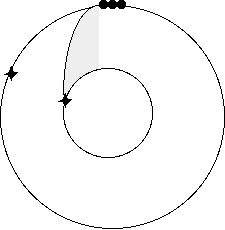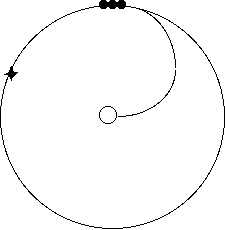
The flant in a line universe sees a star.
Consider A Universe which is a one dimensional circle.
It has one flat ant inhabitant, a flant, and one star.
A simpler model
The flants living on their balloon have a hard time visualizing how their two dimensional world is expanding in time into a three dimensional space. So they create a simpler model. They imagine one dimensional creatures who live on a line. The line is curved into a circle. In this universe there is one creature and one star. Light takes time to travel from the star to the creature. So the creature sees the star as it was in the past.

The arc connecting the flant to the star is the path light follows through spacetime.
Looking in the other direction, and there is only one other direction, there is nothing in the way and so the creature looks out in space and back in time and sees the big bang itself. At the big bang the circle begins as a very tiny circle. After 300,000 years it is a larger circle after 14 billion years it is a very large circle. Light travels from a point of the 300,000 year circle to the 14 billion year circle through space and time.

The flants now understand their balloon. If one of them looks out in space they either see a dot in the past when the balloon was smaller or they see the light coming from the big bang itself. When they and all the dots were at the center of space and time.
We look out into space and see the universe in the past. the farther we look out the older the universe we see. Look out far enough and we can see the big bang itself. Well actually a time 300,000 years after the big bang when the universe became transparent.
|
Scientific Explorations with Paul Doherty |
|
8 November 2004 |